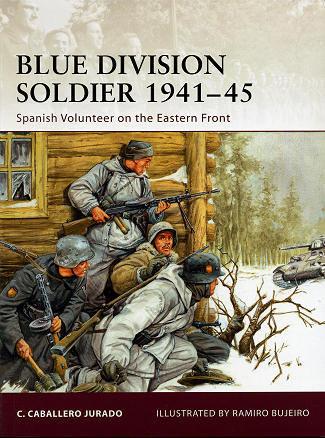 There
were several different nations that fought on the side of the Germans against
the Soviets during WWII. Some of them were nations in the Axis forces while
others were volunteers who, for various reasons, chose to fight. In many cases,
these volunteers were not so much pro-Nazi as they were anti-communist and were
willing to help overthrow the communist regime in Russia and the other Soviet
states. Such is the case of probably the best of these troops, the Spanish Blue
Division.
There
were several different nations that fought on the side of the Germans against
the Soviets during WWII. Some of them were nations in the Axis forces while
others were volunteers who, for various reasons, chose to fight. In many cases,
these volunteers were not so much pro-Nazi as they were anti-communist and were
willing to help overthrow the communist regime in Russia and the other Soviet
states. Such is the case of probably the best of these troops, the Spanish Blue
Division.
These troops were initially made up of Falangist activists
who wanted nothing more than to increase their power in Spanish politics. It was
felt that by forming a distinct armed unit from the regular Spanish army (as in
the Waffen SS) to fight against the communists, that this would help to increase
their influence and perhaps provide them the basis for a loyal army if the time
came to use it. However, the regular Spanish army wasn't stupid and successfully
took over the volunteer process to ensure that it would not be totally Falangist.
Such was the fervor to get into the action once Germany
invaded Russia, that many were turned away. Those that were accepted were
generally well educated college students as well as Falangist sympathizers and
some ex-army people. This first group of volunteers was sent off with much
fanfare for their 1 year tour on the Eastern Front. Though they required
training, they learned very quickly and unlike most of the other volunteer or
Axis units, they were fully equipped with modern German weaponry. They turned
out to be outstanding troops and while there was some friction between regular
German officers and the Spanish, this quickly dissipated once they were thrown
into battle. It is safe to say that the Blue Division was the only non-German
unit that the German army trusted to do its job and stand firm when required.
This not only gave them an outstanding reputation, but also resulted in a rather
high casualty rate. While Spanish army doctrine was not the same as the Germans
in terms of fluid fighting, when it came to defending territory, they were first
rate.
In this book on the Blue Division, author C. Caballero Jurado
covers a brief chronology that led up to the formation of the divsion, followed
by a section on recruitment and organization. We then get to look at how their
training went in Germany before seeing how the units were composed. Then it is
on to life on the Eastern Front. The unit's motivation and morale is next and
amongst all the volunteer units, they were probably the most motivated and with
the highest morale. We then get to see how they operated while on campaign and
then what happened when the war was over and they were repatriated. All of this
is superbly illustrated by Ramiro Bujeiro and a superb collection of period
photographs.
This makes for a most interesting read of a formation of
troops of which few outside of Spain have ever heard. I thoroughly enjoyed this
issue and I know you will as well.
December 2009
For more on the complete line of Osprey books,
visit www.ospreypublishing.com. In the US, it is
Osprey Direct at 44-02 23rd St, Suite 219, Long Island City, NY 11101., where you can
get a catalogue of available books.
If you would like your product reviewed fairly and quickly, please contact
me or see other details in the Note to
Contributors.
 There
were several different nations that fought on the side of the Germans against
the Soviets during WWII. Some of them were nations in the Axis forces while
others were volunteers who, for various reasons, chose to fight. In many cases,
these volunteers were not so much pro-Nazi as they were anti-communist and were
willing to help overthrow the communist regime in Russia and the other Soviet
states. Such is the case of probably the best of these troops, the Spanish Blue
Division.
There
were several different nations that fought on the side of the Germans against
the Soviets during WWII. Some of them were nations in the Axis forces while
others were volunteers who, for various reasons, chose to fight. In many cases,
these volunteers were not so much pro-Nazi as they were anti-communist and were
willing to help overthrow the communist regime in Russia and the other Soviet
states. Such is the case of probably the best of these troops, the Spanish Blue
Division.